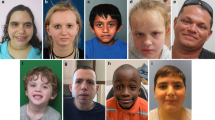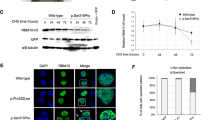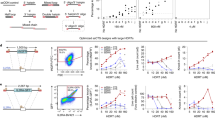Abstract
X-linked mental retardation (XLMR) is an extremely heterogeneous condition that account for 15–25% of all mentally retarded patients. The number of genes newly reported in relation with this condition has been rapidly increased in the past years. One of the latest is called Jumonji AT-rich interactive domain 1C (JARID1C). This gene encodes for a member of a recently discovered protein family that harbours DNA-binding motifs, suggesting a possible role in transcriptional regulation and in the modification of chromatin structure. In this work we describe the results obtained by screening JARID1C gene in 24 mentally retarded males with history of at least two affected males. Remarkably, we have found a novel missense mutation in exon 10 of the gene that results in a Serine-to-arginine change at amino-acid 451 (S451R). This nucleotide change appears to be restricted to mentally retarded patients, since it has not been detected in control samples. Familial analysis has confirmed the segregation of this mutation with mental retardation. Furthermore, sequence alignment analysis with the different members of the human JARID1 family and with homologous proteins of mouse and fruit fly has revealed that the affected amino acid is conserved. Our data highlights the importance of reporting mutations in this gene since it might support the recent findings that implicates JARID1C with XLMR.
Similar content being viewed by others
Log in or create a free account to read this content
Gain free access to this article, as well as selected content from this journal and more on nature.com
or
References
American Association on Mental Retardation. Mental Retardation: Definition, Classification, and Systems of Supports, 10th edn. Washington 2002.
Leonard H, Wen X : The epidemiology of mental retardation: challenges and opportunities in the new millennium. Ment Retard Dev Disabil Res Rev 2002; 8: 117–134.
Fishburn J, Turner G, Daniel A, Brookwell R : The diagnosis and frequency of X-linked conditions in a cohort of moderately retarded males with affected brothers. Am J Med Genet 1983; 14: 713–724.
Turner G : Finding genes on the X chromosome by which homo may have become sapiens. Am J Hum Genet 1996; 58: 1109–1110.
Kleefstra T, Hamel BC : X-linked mental retardation: further lumping, splitting and emerging phenotypes. Clin Genet 2005; 67: 451–467.
Ropers HH, Hamel BC : X-linked mental retardation. Nat Rev Genet 2005; 6: 46–57.
Jensen LR, Amende M, Gurok U et al: Mutations in the JARID1C gene, which is involved in transcriptional regulation and chromatin remodeling, cause X-linked mental retardation. Am J Hum Genet 2005; 76: 227–236.
Ropers HH, Hoeltzenbein M, Kalscheuer V et al: Nonsyndromic X-linked mental retardation: where are the missing mutations? Trends Genet 2003; 19: 316–320.
Ng PC, Henikoff S : SIFT: predicting amino acid changes that affect protein function. Nucleic Acids Res 2003; 31: 3812–3814.
Ramensky V, Bork P, Sunyaev S : Human non-synonymous SNPs: server and survey. Nucleic Acids Res 2002; 30: 3894–3900.
Kortschak RD, Tucker PW, Saint R : ARID proteins come in from the desert. Trends Biochem Sci 2000; 25: 294–299.
Patsialou A, Wilsker D, Moran E : DNA-binding properties of ARID family proteins. Nucleic Acids Res 2005; 33: 66–80.
Marchler-Bauer A, Anderson JB, DeWeese-Scott C et al: CDD: a curated Entrez database of conserved domain alignments. Nucleic Acids Res 2003; 31: 383–387.
Acknowledgements
We thank the family for their cooperation and consent to publish this study and their photographs. This work has received financial support from GIRMOGEN (V2003REDG 03-98), REDGEN (V2003REDC 07), INERGEN (C03/05), PI050776, PI050159, and V2004-FS041126-0 financed by the ‘Fondo de Investigación Sanitaria’, Spain.
Author information
Authors and Affiliations
Corresponding author
Rights and permissions
About this article
Cite this article
Santos, C., Rodriguez-Revenga, L., Madrigal, I. et al. A novel mutation in JARID1C gene associated with mental retardation. Eur J Hum Genet 14, 583–586 (2006). https://doi.org/10.1038/sj.ejhg.5201608
Received:
Revised:
Accepted:
Published:
Issue date:
DOI: https://doi.org/10.1038/sj.ejhg.5201608
Keywords
This article is cited by
-
A novel de novo KDM5C variant in a female with global developmental delay and ataxia: a case report
BMC Neurology (2021)
-
Loss of PHF6 leads to aberrant development of human neuron-like cells
Scientific Reports (2020)
-
Histone lysine demethylases as targets for anticancer therapy
Nature Reviews Drug Discovery (2013)
-
Histone Methylation in the Nervous System: Functions and Dysfunctions
Molecular Neurobiology (2013)
-
Multilocus loss of DNA methylation in individuals with mutations in the histone H3 Lysine 4 Demethylase KDM5C
BMC Medical Genomics (2013)



